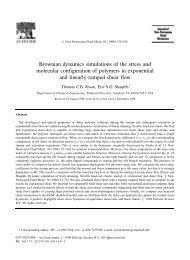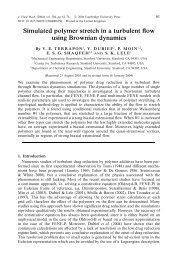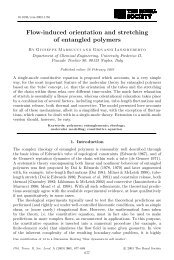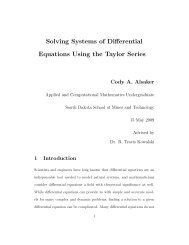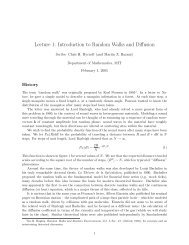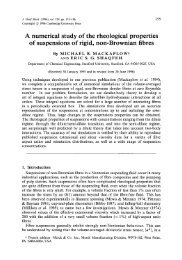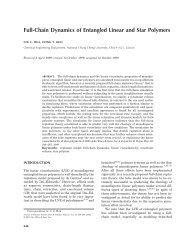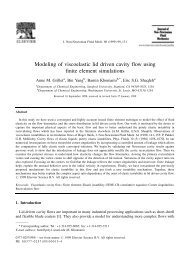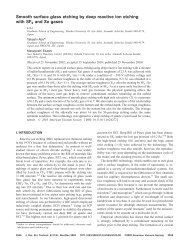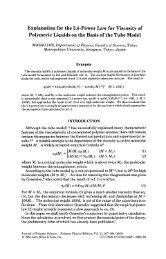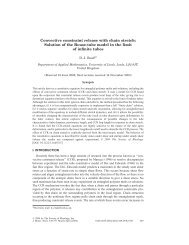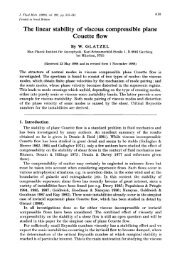Molecular modelling of entangled polymer fluids under flow The ...
Molecular modelling of entangled polymer fluids under flow The ...
Molecular modelling of entangled polymer fluids under flow The ...
You also want an ePaper? Increase the reach of your titles
YUMPU automatically turns print PDFs into web optimized ePapers that Google loves.
2.4. CHAIN STRETCH AND CONSTRAINT RELEASE 33<br />
low anisotropy observed in sheared melts [Müller et al. (1993)] when compared to the<br />
predictions <strong>of</strong> the DE theory.<br />
2.4.1 <strong>The</strong> Milner McLeish and Likhtman model<br />
In this section I present a brief review <strong>of</strong> the model <strong>of</strong> Milner McLeish and Likhtman<br />
(MMcL) for convective constraint release. <strong>The</strong> model describes the dynamics <strong>of</strong> a<br />
monodisperse melt <strong>of</strong> <strong>entangled</strong>, linear <strong>polymer</strong> molecules <strong>under</strong> a strong deformation.<br />
<strong>The</strong> chain is confined to a tube <strong>of</strong> diameter a due to constraints formed by surrounding<br />
chains and the aim <strong>of</strong> the model is to derive dynamic equations for the entire configuration<br />
<strong>of</strong> a single chain down to the length-scale <strong>of</strong> the tube diameter. <strong>The</strong> configuration<br />
is described by the space curve R(s, t) which denotes the position vector <strong>of</strong> tube segment<br />
s at time t. <strong>The</strong> tube comprises <strong>of</strong> Z = M/M e segments and s spans the chain<br />
length, running from 0..Z. From a knowledge <strong>of</strong> the chain shape various macroscopic<br />
quantities can be deduced.<br />
<strong>The</strong> model accounts for a range <strong>of</strong> sources <strong>of</strong> motion and each process has a corresponding<br />
term in the Langevin equation which models the dynamics <strong>of</strong> the entire<br />
chain. <strong>The</strong> simplest <strong>of</strong> these is convection due to the applied deformation. <strong>The</strong> deformation<br />
is described by the velocity gradient tensor, κ<br />
≈<br />
, and all points on the chain<br />
move affinely with the <strong>flow</strong>. Relaxation is then relative to this affine motion. Three<br />
relaxation mechanisms act on each tube segment. <strong>The</strong> first <strong>of</strong> these is reptation which<br />
is curvilinear diffusion <strong>of</strong> the entire chain along its own contour. This processes relaxes<br />
stress since the chain ends escaping the tube are free to choose any new orientation.<br />
<strong>The</strong> expression for reptation is taken directly from the original DE model. <strong>The</strong> second<br />
process is CCR which is assumed to act at an equal rate at all points along the chain.<br />
It is modelled by Rouse tube hops <strong>of</strong> length a and frequency ν. Finally, retraction acts<br />
along the tube contour, holding the total length fixed at its equilibrium value. <strong>The</strong><br />
retraction rate is proportional to the distance <strong>of</strong> the segment from the chain centre and<br />
the constant <strong>of</strong> proportionality, λ, is chosen at each instant to maintain the chain at<br />
its equilibrium length. Figure 2.12 shows these processes schematically.<br />
Collecting all terms together into a Langevin equation for a single chain gives<br />
(<br />
R(s, t + ∆t) = R(s + ∆ξ(t), t) + ∆t κ .R + 3ν<br />
≈ 2<br />
∂ 2 R<br />
∂s 2<br />
( ) )<br />
Z ∂R<br />
+ g(s, t) + λ 2 − s .<br />
∂s<br />
(2.36)<br />
<strong>The</strong> terms in equation 2.36 represent reptation, convection, CCR and retraction, respectively.<br />
Appendix 2.III contains a derivation <strong>of</strong> the term corresponding to Rouse<br />
like motion due to constraint release. Equation 2.36 contains two noise terms: ∆ξ(t)<br />
describes Brownian forces leading to motion along the tube (reptation) and g(s, t) describes<br />
motion due to random constraint release events.<br />
Both terms are mean zero



